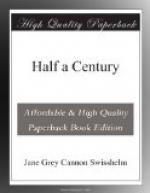Then I learned that I had been expected to secure the fall crops on mother’s lot, and this was not unreasonable, for I had married a Pennsylvania farmer, and their wives and sisters and daughters did such work often, while the “men folks” pitched horseshoes to work off their surplus vitality. Lack of strength was no reason why a woman should fail in her duty, for when one fell at her post, there was always another to take her place.
Up to this time mother had left me to settle my troubles, but now, she told me I must turn and demand justice; that generosity was more than thrown away; that I never could live with my husband and bear his neglect and unkindness and that of his family. I must leave him, defend myself, or die. That I should have been expected to gather apples and dig potatoes, filled her with indignation. She advised me to stay with her and refuse to see him, but I shuddered to think it had come to this in one short year, and felt that all would yet be well. So I went to live in the house he provided for me, his mother furnished my supplies, and he came once a week to see me.
Here let me say, that in my twenty years of married life, my conflicts were all spiritual; that there never was a time when my husband’s strong right arm would not be tempered to infantile gentleness to tend me in illness, or when he hesitated to throw himself between me and danger. Over streams and other places impassible to me, he carried me, but could not understand how so frail a thing could be so obstinate.
CHAPTER VIII.
FITTING MYSELF INTO MY SPHERE.—AGE, 22, 23.
During all my girlhood I saw no pictures, no art gallery, no studio, but had learned to feel great contempt for my own efforts at picture-making. A traveling artist stopped in Wilkinsburg and painted some portraits; we visited his studio, and a new world opened to me. Up to that time portrait painting had seemed as inaccessible as the moon—a sublimity I no more thought of reaching than a star; but when I saw a portrait on the easel, a palette of paints and some brushes, I was at home in a new world, at the head of a long vista of faces which I must paint; but the new aspiration was another secret to keep.
Bard, the wagon-maker, made me a stretcher, and with a yard of unbleached muslin, some tacks and white lead, I made a canvas. In the shop were white lead, lampblack, king’s yellow and red lead, with oil and turpentine. I watched Bard mix paints, and concluded I wanted brown. Years before, I heard of brown umber, so I got umber and some brushes and begun my husband’s portrait. I hid it when he was there or I heard any one coming, and once blistered it badly trying to dry it before the fire, so that it was a very rough work; but it was a portrait, a daub, a likeness, and the hand was his hand and no other. The figure was correct, and the position in the chair, and, from the moment I began it, I felt I had found my vocation.




